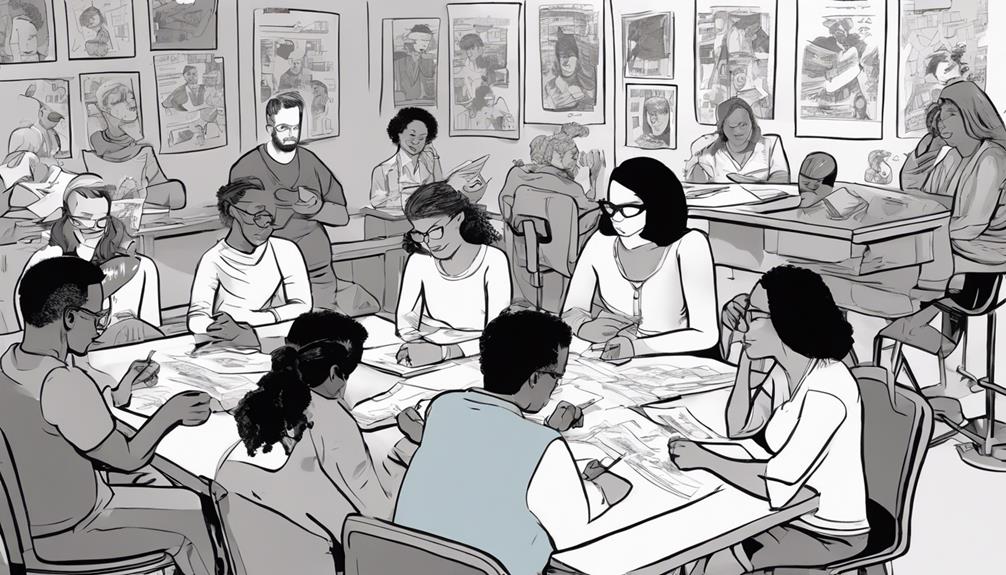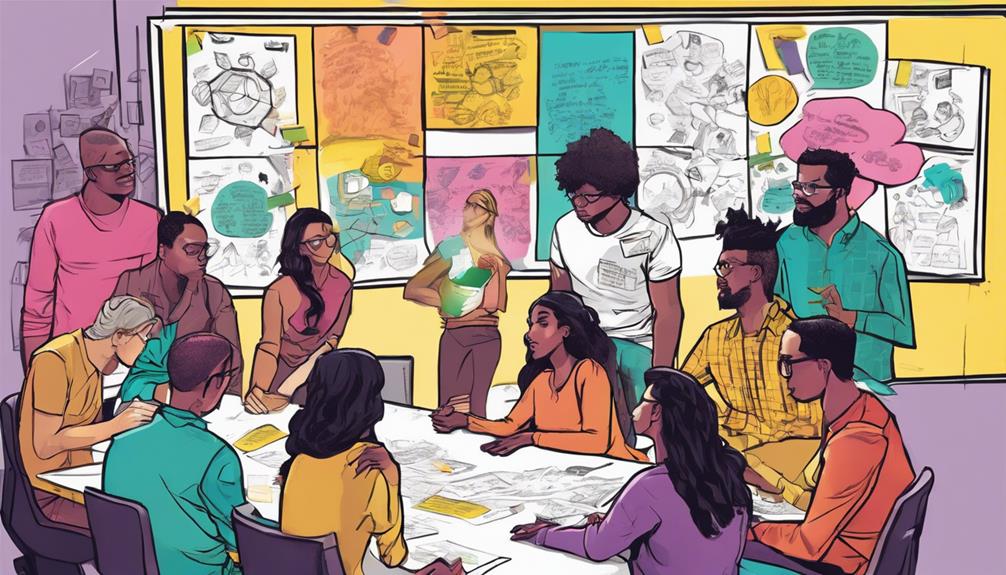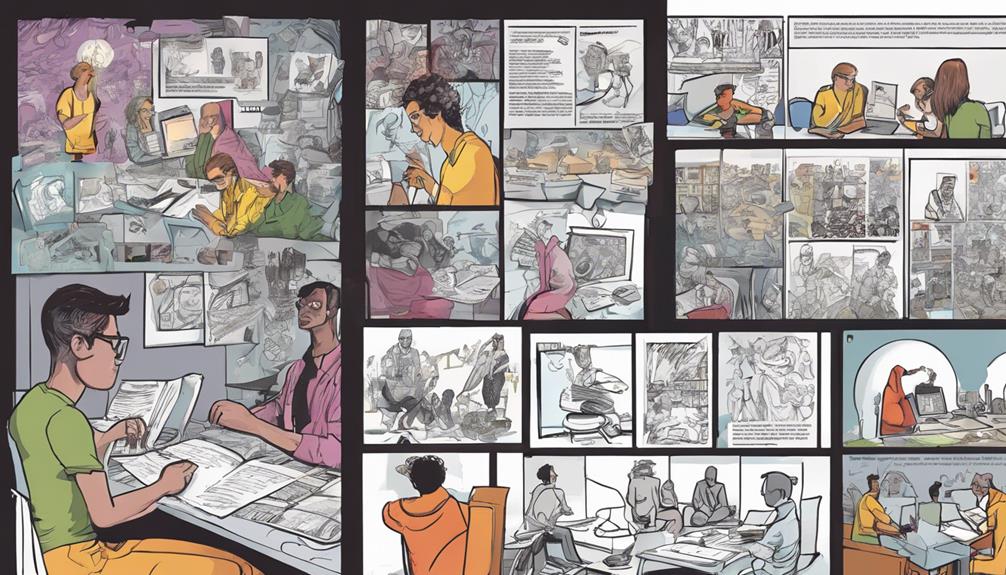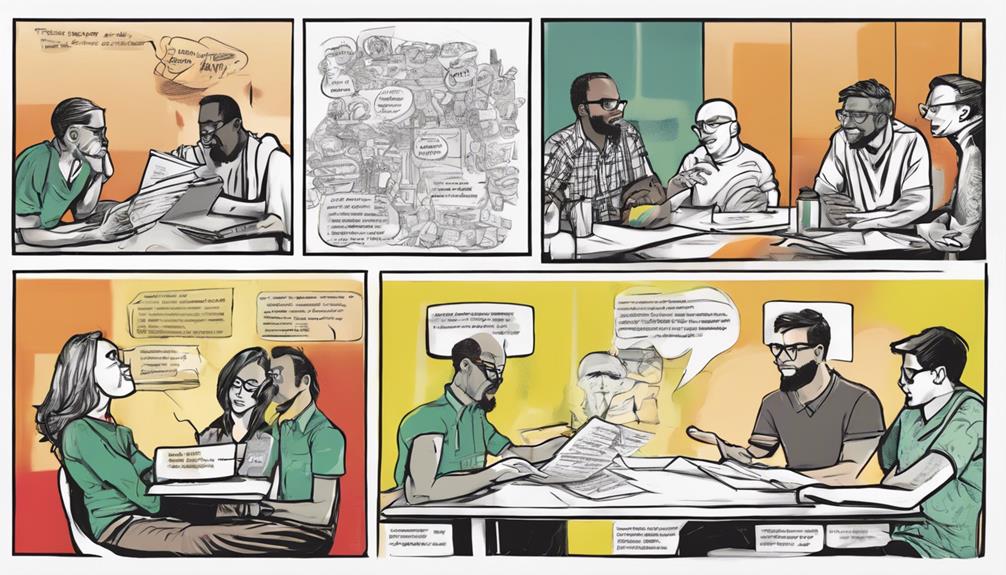Begin on a journey through the dynamic stages of design thinking. Start by empathizing with users to uncover their true needs. Dive deep into problem definition to pinpoint the root issues. Then, let your creativity flow during the ideation process. Bring ideas to life through prototyping and gather valuable feedback through testing. These stages lead to impactful solutions that resonate with users. Intrigued? Keep exploring for a deeper understanding of how design thinking can revolutionize problem-solving and innovation.
Key Takeaways
- Empathize: Understand users' needs and emotions deeply.
- Define: Reframe challenges and establish a clear problem statement.
- Ideate: Brainstorm creative solutions collaboratively.
- Prototype: Transform ideas into tangible representations for testing.
- Test: Validate solutions through rigorous testing with real users.
Design Thinking Overview
Design thinking offers a user-centered approach that emphasizes empathy towards users' needs and experiences. By delving deep into understanding users and their needs, design thinking enables teams to tackle problems in a structured yet flexible process. This approach ensures that solutions developed aren't only innovative but also resonate with the intended users. Design thinking encourages teams to view challenges from a fresh perspective, leading to creative and enduring solutions that address the root of the problem.
Through a focus on empathy and understanding, design thinking fosters a culture of innovation where solutions aren't just technically feasible but also desirable for users. By involving users throughout the design process, teams can gain valuable insights that drive the creation of impactful solutions. This user-centric approach has been linked to improved problem-solving, team collaboration, and overall business success, making design thinking a powerful methodology for driving innovation.
Empathizing Stage

Immerse yourself in users' experiences during the empathizing stage of the design thinking process to gain valuable insights. This stage is all about empathy, focusing on understanding users' emotions, motivations, and behaviors deeply. By immersing oneself in the users' world, designers can uncover hidden pain points and gain a human-centered approach to problem-solving.
During the empathizing stage, observing and engaging with users is essential to develop a profound understanding of their needs and challenges. This process of gathering user insights forms the backbone of creating solutions that address users' real problems effectively. Insights gathered at this stage serve as the foundation for the subsequent stages of the design thinking process.
Problem Definition

During the problem definition stage of design thinking, you distill user insights into a focused and actionable problem statement. This phase is essential for setting the direction of the design process by identifying the core issue that needs to be addressed.
Here's how you can navigate through the problem definition stage effectively:
- Synthesizing User Insights: Gathered from the empathizing stage, these insights provide a deep understanding of users' needs and pain points, which serve as the foundation for problem definition.
- Reframing Challenges: By looking at the problems from the users' perspective, you can reframe challenges to guarantee the problem statement is aligned with users' actual experiences and desires.
- Identifying Root Causes: It's crucial to dig deeper into the root causes of users' needs to create a clear and actionable problem statement that directly addresses the underlying issues.
Ideation Process

Now, let's discuss the Ideation Process in design thinking.
In this stage, you'll focus on generating a wide range of creative solutions through techniques like brainstorming and mind mapping.
Collaborating with your team is essential to foster creativity and explore innovative ideas effectively.
Divergent Idea Generation
Engage in divergent idea generation to explore a multitude of innovative solutions during the ideation process in design thinking. This phase involves free-flowing and non-judgmental brainstorming sessions that encourage thinking outside the box. By incorporating techniques like mind mapping, teams can spark innovative solutions through collaborative ideation.
Here's how you can make the most of the divergent idea generation process:
- Encourage Creative Ideation Sessions: Foster an environment where all ideas are welcomed, no matter how unconventional they may seem. This approach allows for a wide range of solutions to be explored.
- Embrace Collaborative Ideation: Work together with your team to build on each other's ideas and inspire new ones. Collaborative efforts often lead to more innovative outcomes.
- Utilize Techniques like Mind Mapping: Visualize connections between ideas and concepts to stimulate creativity and generate a plethora of potential solutions. Mind mapping can help structure thoughts in a way that enhances the ideation process.
Collaborative Brainstorming Techniques
Utilize collaborative brainstorming techniques to foster a dynamic environment for generating a diverse range of innovative solutions during the ideation process in design thinking. Group sessions are fundamental in this process, allowing for the exploration of creative solutions through methods like brainwriting, mind mapping, and SCAMPER.
These techniques promote divergent thinking by encouraging participants to build upon each other's ideas, leading to a more inclusive pool of concepts. Collaborative ideation not only fuels innovation but also ensures a wide spectrum of perspectives is considered, enhancing the quality of potential solutions.
Effective facilitation plays a vital role in guiding brainstorming sessions, ensuring that all team members contribute and feel valued in the ideation process. By incorporating diverse perspectives and leveraging the collective creativity of the group, collaborative brainstorming techniques set the stage for generating impactful and inventive ideas in design thinking.
Creative Solution Exploration
During the ideation process in design thinking, teams engage in brainstorming and creative solution exploration to generate a wide array of innovative ideas.
Here are three key aspects to contemplate during this phase:
- Divergent Thinking:
Embrace a mindset that encourages thinking outside the box and exploring unconventional solutions. By diverging from traditional paths, you can uncover unique concepts that may lead to breakthrough innovations.
- Collaboration:
Foster a collaborative environment where team members can freely share their thoughts and build upon each other's ideas. Collaborative ideation sessions often result in more robust and diverse solutions that cater to a wider range of user needs.
- Sketching and Mind Mapping:
Use visual tools like sketches and mind maps to represent ideas visually and facilitate better understanding and communication within the team. These techniques can help in organizing thoughts and connecting different concepts to form coherent solutions.
Prototyping Phase

In the Prototyping Phase of design thinking, ideas are transformed into tangible representations for testing and refinement. Prototypes, ranging from low fidelity sketches to high fidelity models, allow for iterative development and feedback. Testing these prototypes with actual users is crucial to uncover usability issues and validate assumptions before final implementation. This iterative prototyping process ensures that solutions are user-centered and innovative, meeting users' needs effectively. The prototyping phase acts as a bridge between ideation and implementation, leading to the creation of practical and innovative solutions.
| Key Aspect | Description |
|---|---|
| Prototyping | Transforming ideas into tangible representations for testing and refinement. |
| Iterative | Allowing for quick iteration and feedback to enhance the design process. |
| Feedback | Gathering insights from testing prototypes with actual users for improvement. |
| Testing | Uncovering usability issues and validating assumptions before final implementation. |
| User-Centered | Ensuring that solutions meet users' needs and expectations effectively. |
Testing and Validation

To guarantee the effectiveness of your design solutions, the Testing and Validation phase involves evaluating prototypes with real users for feedback and validation. Here are some key aspects to keep in mind during this phase:
- User Research and Empathy:
Conduct thorough user research to understand the needs and preferences of your target audience. Empathy is crucial in designing solutions that truly resonate with users.
- Prototyping and Testing:
Create prototypes to visualize your ideas and test them with real users. Iterative testing allows for incremental improvements based on user feedback, leading to refined solutions.
- Validation through Testing:
Validate your design concepts through rigorous testing with real users. This process helps in uncovering usability issues, validating assumptions, and ensuring that the final product meets user expectations.
Design Thinking Stages

Design thinking involves a structured process comprising five key stages aimed at fostering creativity and problem-solving. The stages – Empathize, Define, Ideate, Prototype, and Test – form an in-depth exploration into design thinking methodologies.
In the Empathize stage, designers focus on understanding user needs by gathering user insights. Moving on to Define, the goal is to define the problem and establish a clear understanding of the challenge at hand. Ideate encourages the generation of innovative solutions through brainstorming and ideation sessions. Prototype involves creating tangible representations of ideas to move towards product development.
Real-World Applications

You'll explore how Design Thinking tackles industry-specific challenges and the practical strategies for implementing it effectively.
Discover how this approach has reshaped healthcare, technology, education, and more, propelling innovation and collaboration.
Uncover the ways in which Design Thinking drives impactful solutions across diverse sectors, revolutionizing traditional practices.
Industry-Specific Design Challenges
Industry-specific design challenges present unique opportunities for applying Design Thinking principles to solve real-world problems and drive innovation. When tackling these challenges, a human-centered approach to innovation is essential. By deeply understanding user insights and fostering empathy with users, designers can gain profound insights into the needs and desires of their target audience.
The iterative nature of Design Thinking allows for continuous improvement based on feedback, ensuring that the final product meets user expectations and enhances the user experience.
- Tailoring Solutions to Complex Problems: Design Thinking enables teams to tackle complex industry-specific challenges by breaking them down into manageable segments and addressing them systematically.
- Creating Innovative and Impactful Solutions: By incorporating user insights and feedback, designers can develop innovative and deeply impactful solutions that resonate with users and drive meaningful change within the industry.
- Enhancing User Experience Across Platforms: Design Thinking empowers organizations to improve user experience consistently across various products and services, ultimately leading to increased customer satisfaction and loyalty.
Practical Implementation Strategies
Implementing Design Thinking in real-world scenarios involves adapting the methodology to suit specific contexts and challenges, ensuring practical and effective solutions are developed.
To achieve this, organizations can follow key implementation strategies. To start with, prioritizing empathy and understanding user needs throughout the design thinking process is essential. This human-centered approach ensures that solutions resonate with the end-users, leading to greater satisfaction and usability.
Next, fostering cross-functional collaboration among team members from diverse backgrounds enhances creativity and problem-solving capabilities. By incorporating various perspectives, innovative solutions can be generated that address complex issues effectively.
To conclude, focusing on user-centered solutions and leveraging the stages of design thinking – from ideation to prototyping and testing – enables the development of tailored and impactful outcomes. By following these practical implementation strategies, companies like Mayo Clinic, IBM, and Stanford have successfully applied Design Thinking to drive positive changes in their respective fields.
Frequently Asked Questions
What Is the Deep Dive Method of Design?
The intensive exploration method of design involves thorough exploration and analysis of a specific aspect of a project or problem. It plunges deeply into understanding user needs, constraints, and opportunities, leading to innovative ideas and refined solutions.
What Is the 5 Stages in Design Thinking?
The 5 stages in design thinking are Empathize, Define, Ideate, Prototype, and Test. You understand users' needs, define the problem, brainstorm solutions, create prototypes, and test them iteratively. This process fosters innovation and user-centered design.
What Is the Stage Design Thinking?
The stage of design thinking entails understanding users' needs deeply. By empathizing, you immerse yourself in their world, gaining insights for creating solutions that truly address their challenges and desires. This stage sets the foundation for innovative designs.
What Are the 4 Processes of Design Thinking?
You gotta immerse yourself in design thinking with empathy, defining, ideating, and prototyping. Feel the user's world, solve a clear problem, brainstorm wild ideas, and make real prototypes for testing. That's the process!
Conclusion
So there you have it, folks! Design thinking may seem like a fancy term, but it's just a fancy way of saying 'use your brain to solve problems.'
Remember, empathy is key, brainstorming is essential, and making a prototype is basically adult arts and crafts.
So go forth, dear reader, and design your way to success! Just don't forget to test your ideas before you release them on the world.
Happy designing!









